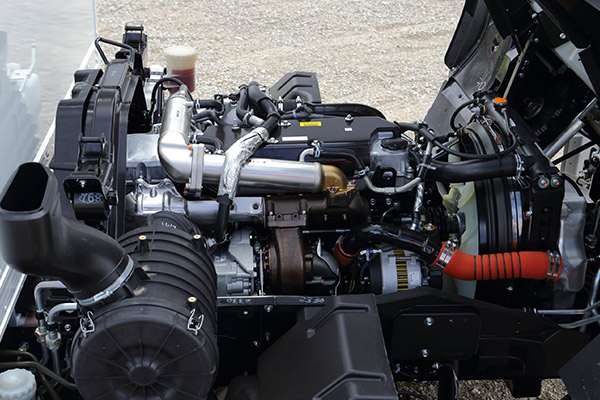The Japanese truck maker has revealed a new medium-duty line-up with a fresh engine range, interior, and transmission option
Isuzu Australia has launched its newest medium-duty range at an event in Melbourne this week, unveiling the 2016 F-Series truck line-up with new engines, new look, and a new transmission option.
In a “severe usage” market, Isuzu Australia managing director and CEO Koichi (Mike) Yoda says the company focused on reliability and durability when bringing the range to Australia and hopes the new F-Series will cater for broader customer needs.
The biggest change comes in the form of two new drivelines for the Isuzu range; the four-cylinder 4HK1 turbo-charged and intercooled diesel engine and the six-cylinder 6HK1 engine with Diesel Oxidation Catalyst (DOC) technology.
“We’re all too aware that the aims and ambitions of many larger fleets, as well as owner drivers, are aligned to sourcing better outcomes for our environment,” director and COO Phil Taylor says.
“We’ve responded to that, in particular, with the new 4HK1 engine technology, which is the cleanest Japanese medium-duty diesel engine currently available.”
Isuzu says the smaller engine, which meets the Euro 6 emissions standard, is a “low displacement, high horsepower” option thanks to a 5.2-litre capacity and two-stage turbocharger pumping out either 154kW (207hp; 726Nm of torque) or 177kW (237hp; 765Nm of torque).
The lower power rating will appear in the new Isuzu FRR, FRD and FSS 4×4 with gross vehicle weights (GVMs) spanning 10.7- to 11-tonnes, while the later will feature in the FRR at 11-tonnes GVM and FSR at 12- and 14-tonnes GVM, respectively.
“For these models, the new 4HK1 replaces a six-cylinder engine, yet offers the same peak power and up to eight per cent more torque,” Isuzu says.
The second of the new engines, the 6HK1 (pictured below), is a 7.8-litre water-cooled, direct-injection diesel engine with an output of 191kW (256hp; 761Nm of torque) and Euro 5 emissions standard.
The addition of DOC to the exhaust and emissions systems removes the need for selective catalytic reduction (SCR) or diesel particulate filter regenerations, Isuzu says, making it the only medium-duty truck engine to do so.
The truck maker says this will reduce service frequency for vehicles.
Isuzu says the new engine design offers “higher engine performance, lower emissions and lower fuel consumption,” and is available in various Isuzu FRR, FSR, FSD, FTR and FTS models, plus the new FVR/D model.
TRANSMISSION
Joining the new engines is a new torque converter-equipped automated manual transmission (TC-AMT), bringing the number of automatic transmission options in the Isuzu line-up to three – joining the Allison 2500 Series automatic and the Allison MD 3000.
Isuzu says the new torque converter AMT features an upsized fluid coupling, similar to those used in full automatic transmissions, and a new ‘stator’, which alters oil flow within the converter function itself and, in conjunction with a number of parts, multiplies the overall torque produced.
This change will be seen when accelerating from a standing start, chief engineer, product strategy Simon Humphries says.
“Our previous AMT models provide dual-function flexibility to best suit changing driving conditions, and have proved particularly popular with motorhome manufacturers, rental companies, and metropolitan and urban fleets, who battle the rigours of stop-start traffic on a daily basis,” he says.
“The addition of a torque converter AMT to the new F Series range is a direct result of those, and other Isuzu customers anticipating responsiveness from a standing start.”
Also updated in the third-generation TC-AMT is the lock-up clutch damper characteristic and the heat treatment for the friction plate, separation plate, and hub of the gearshift clutch.
The new technology is available for all FRR and FSR models equipped with the 4HK1 engine, and sits next to the Allison LCT 2500 and MD 3000 automatics applied to the 6HK1 engine offering.
The six-speed Allison LCT 2500 is suitable for the FRR, FSR, FSD, FTR and FTS models with the 6HK1 engine, while the six-speed MD 3000 is available for the entry-level FVD and FVR models.
For those after manuals, the MZW six-speed, air-assisted manual transmission is available for most of the 2016 F-Series range and the ZF nine-speed air assisted transmission is applicable for the heavy-end of the range.
“The 2016 F Series has been purpose designed to appeal to the broadest range of customers and applications across the Australian road transport industry,” Humphries says.
“The transmission choice in the 2016 F Series range clearly illustrates this.”
Interior and Exterior
When it comes to the exterior of the cab, the new Isuzu F-Series range has a new grille design, badging and nomenclature, after Isuzu choose to switch to denominations in the 100s.
Inside, the new range has a revised seat trim and steering wheel design across the line-up, and passenger-side seats in the FTS range and the FTR crew-cab models are now ISRI 6860 air suspension seats.
The dash-mounted display has been revamped, as has the entertainment system to include sat nav as standard, with the exception of 4×4 models.
Idle-stop technology, defined as the Idle Stop System (ISS) by Isuzu, will also aid to the driving experience, with the truck switching off the engine at appropriate times to save fuel and emissions.
The system, which can be halted, is standard on all 4×2 trucks with the 4HK1 engine, except for the power take-off (PTO) variants.
In other changes to the Isuzu F-Series range, ABS has been updated; Hill Start Aid is available in manual transmission FSS and FTS 4×4 models; rear seats in crew-cab models have also been updated, with more padding and a realigned back rest; a 90 amp alternator has been added; and Meritor axles are now factory-fitted.
The gap between oil changes has also been extended from 15,000km to 20,000km.





